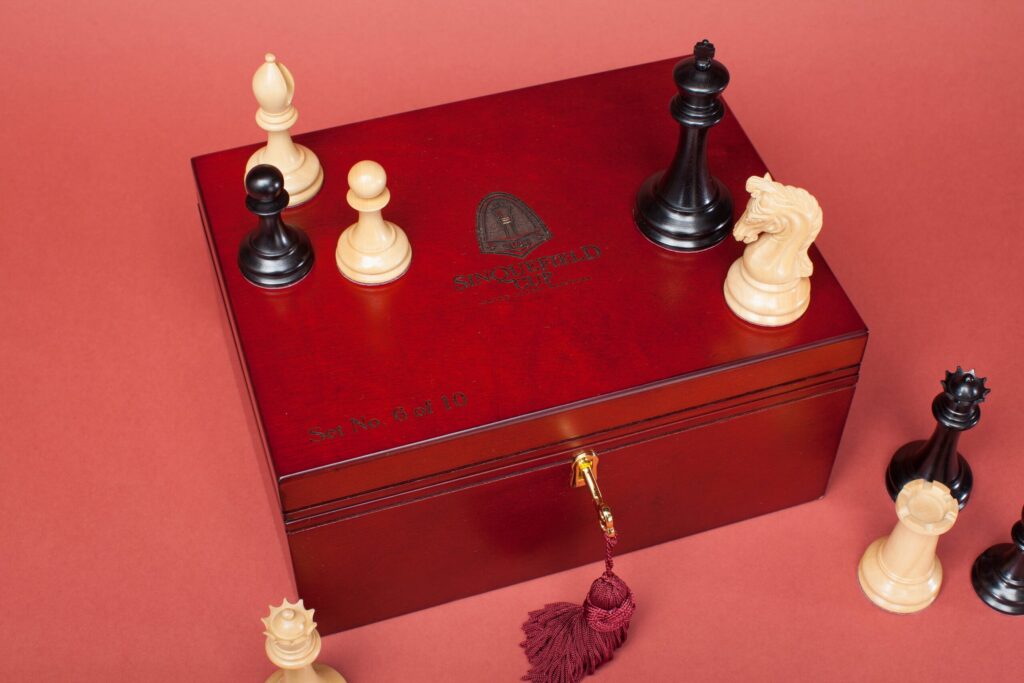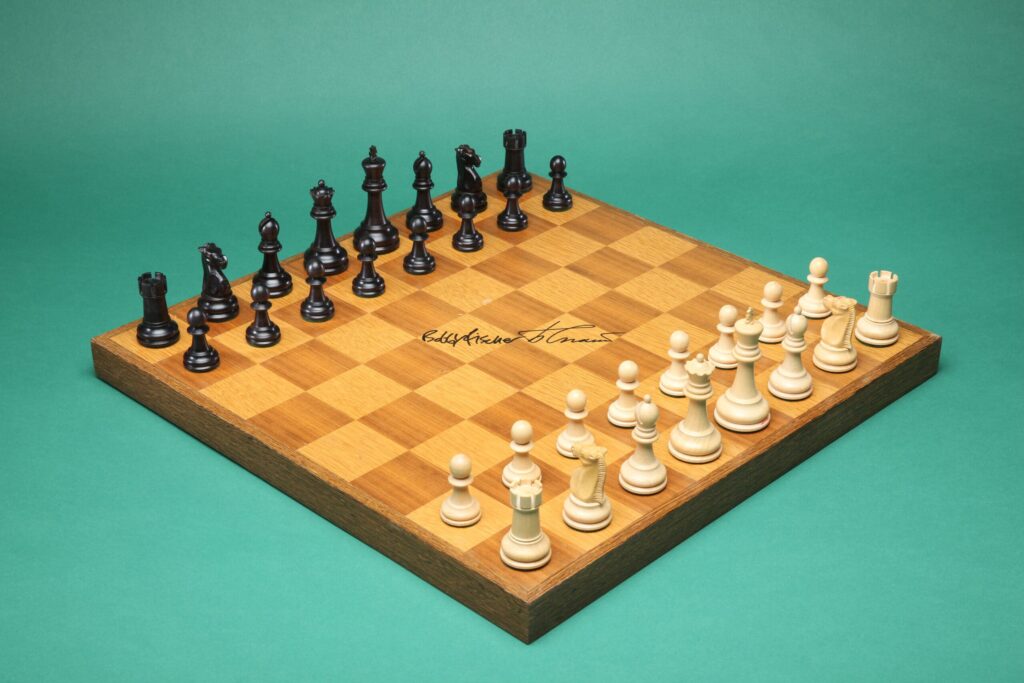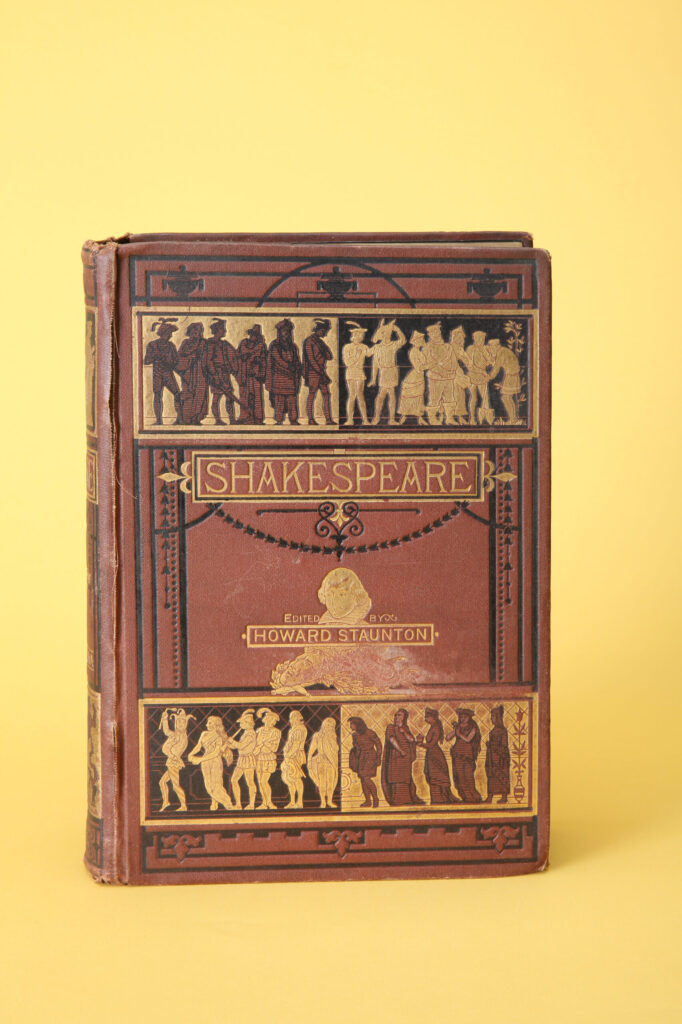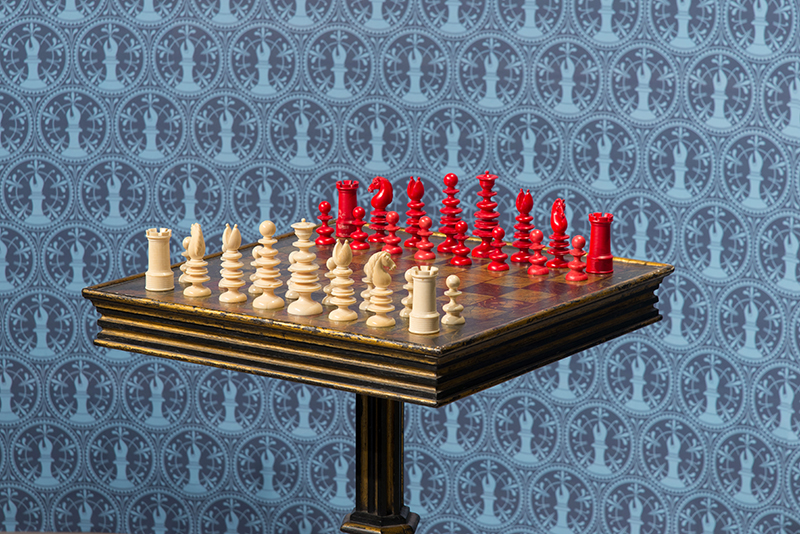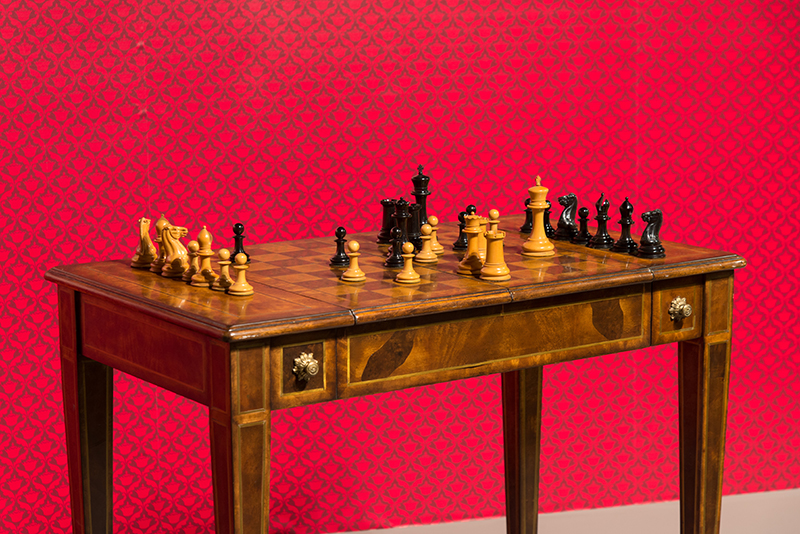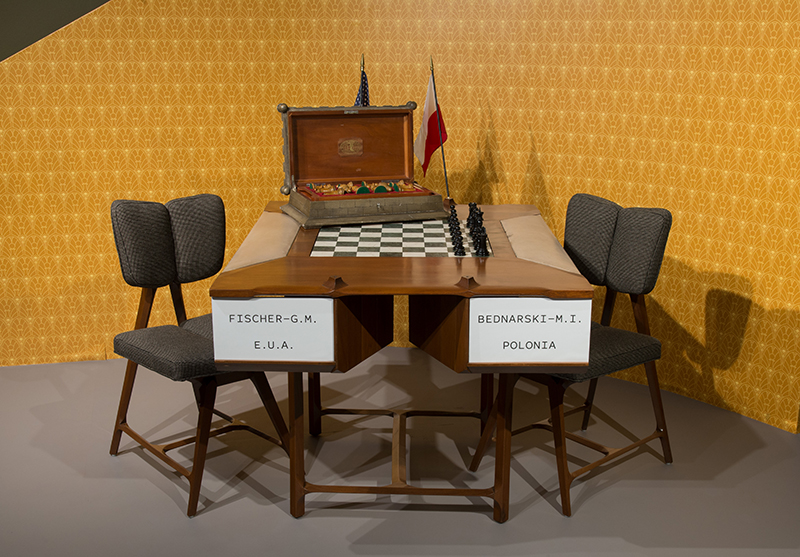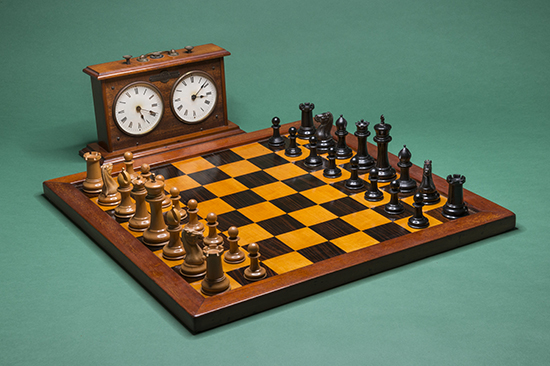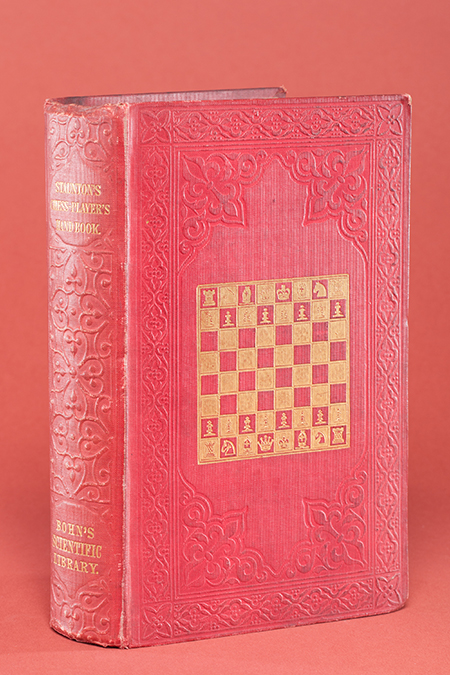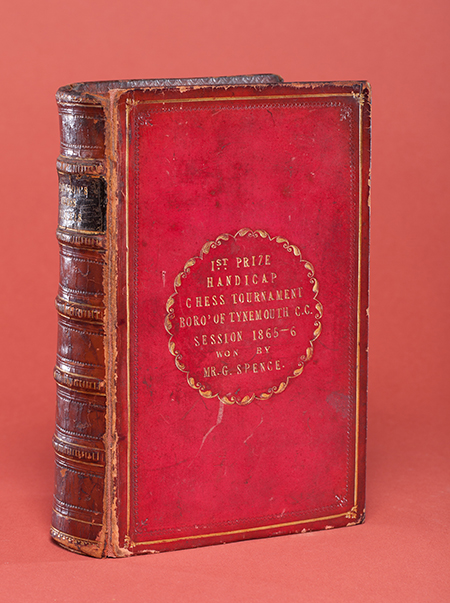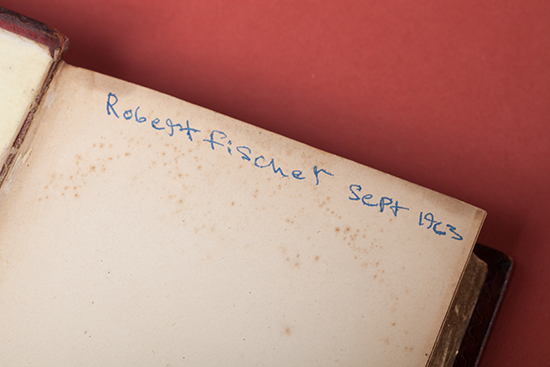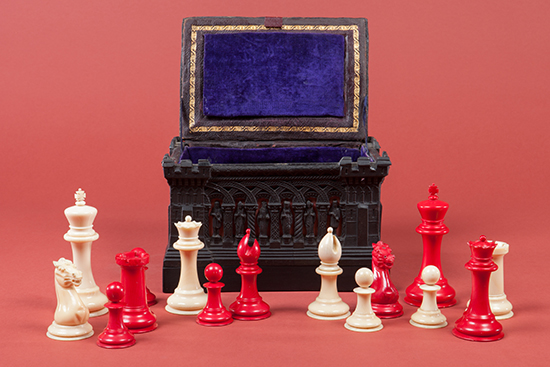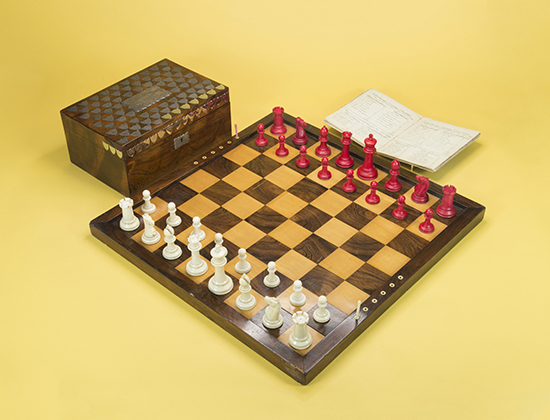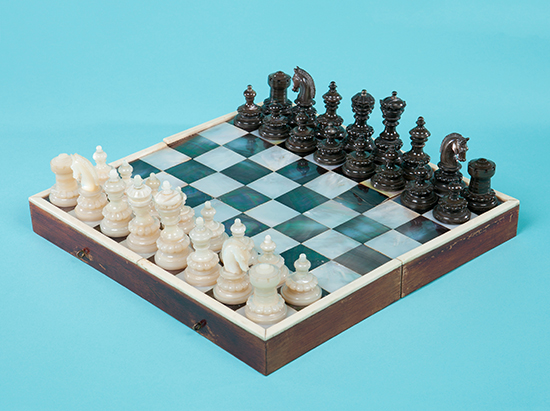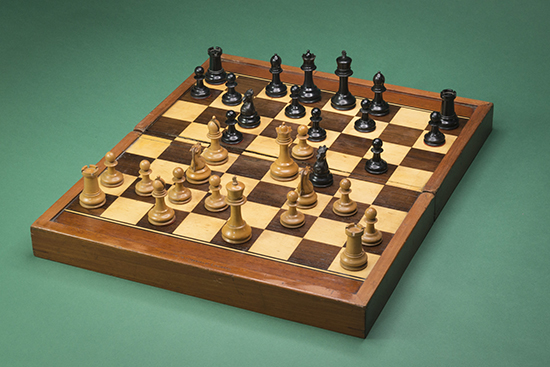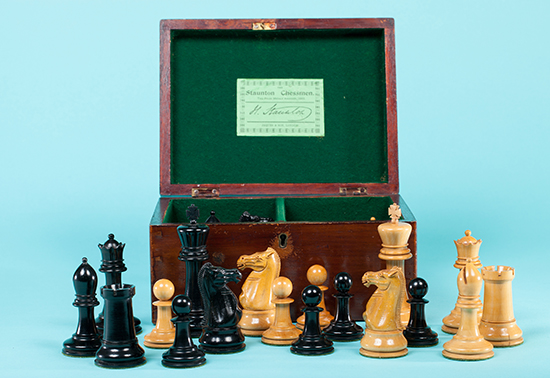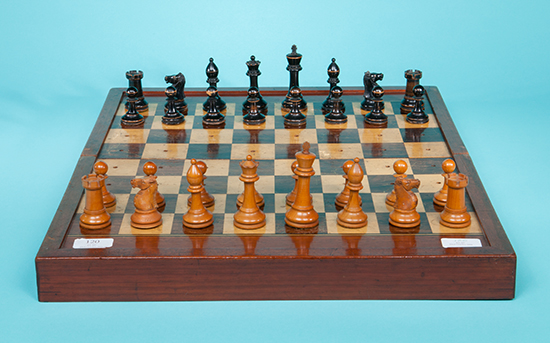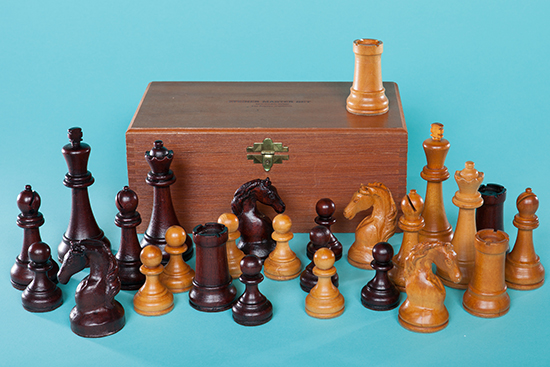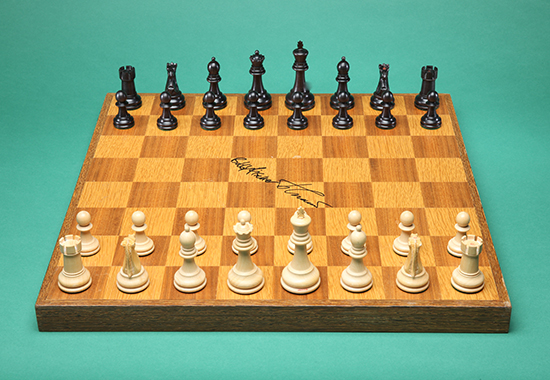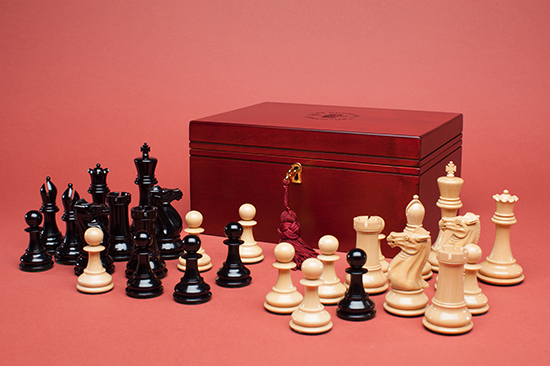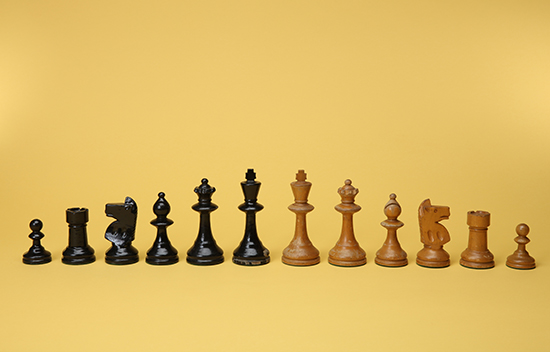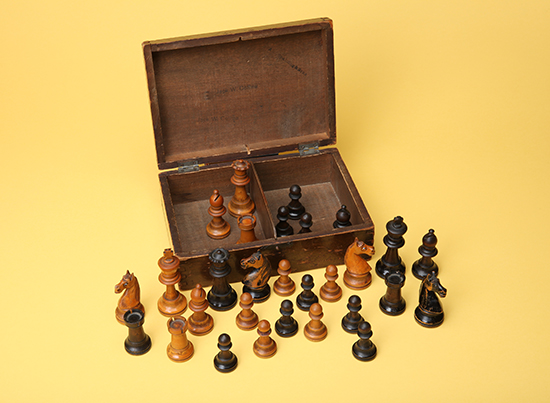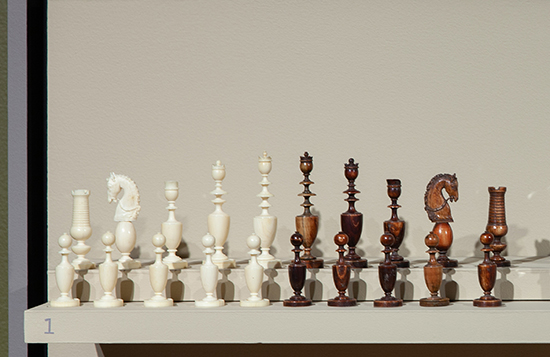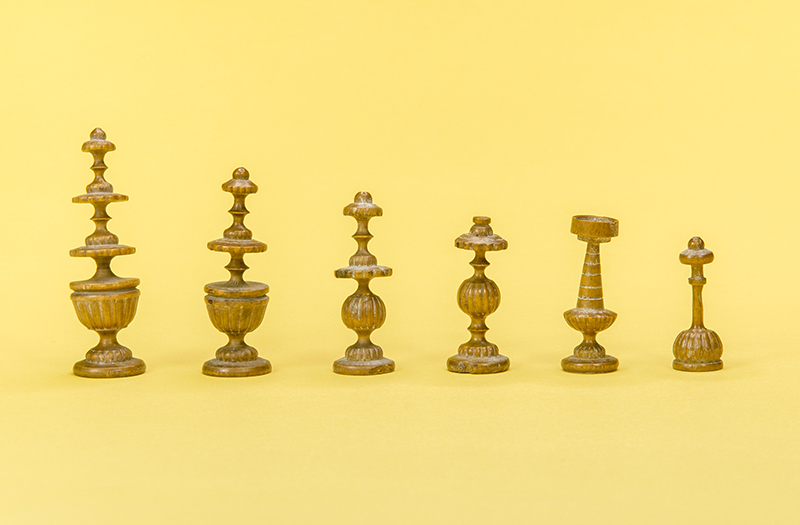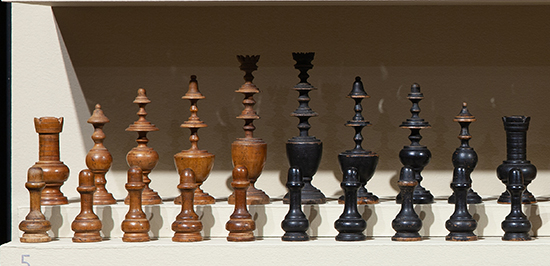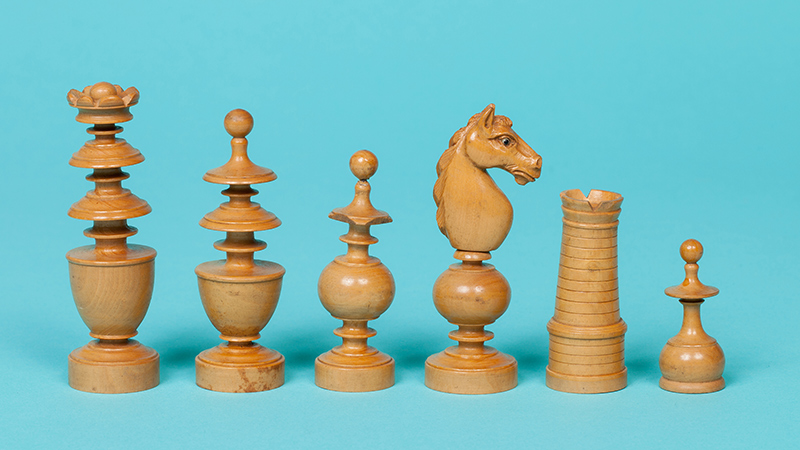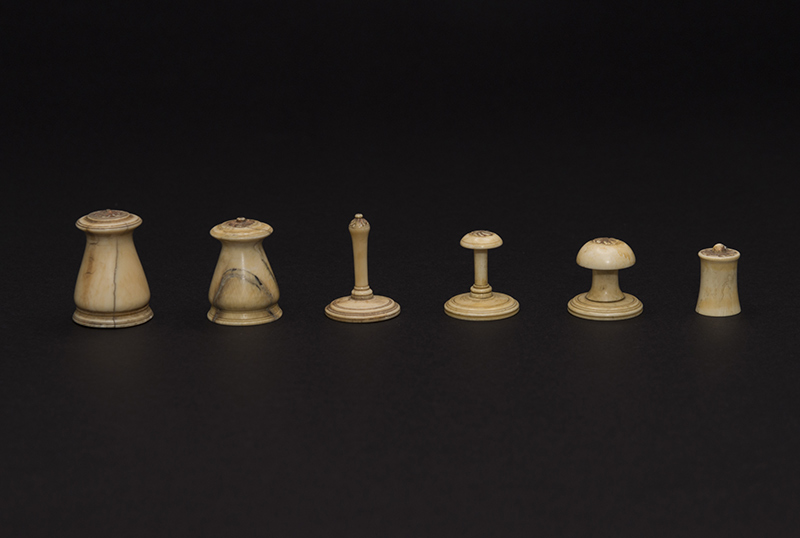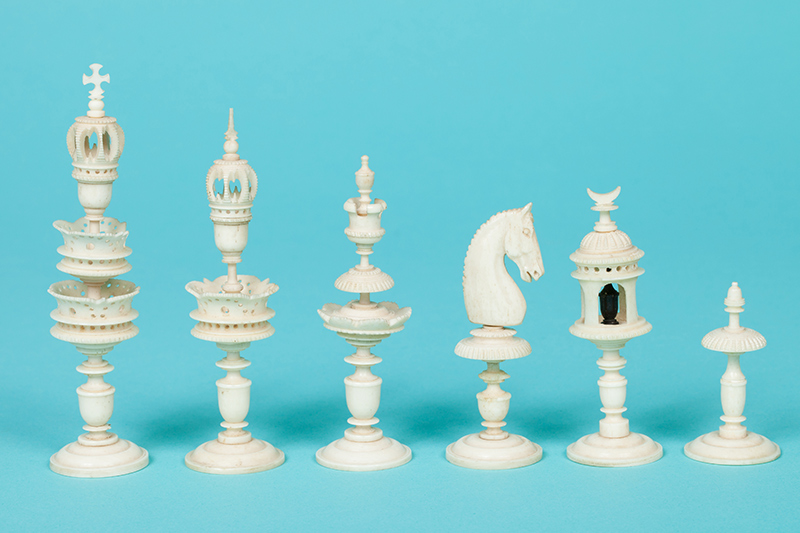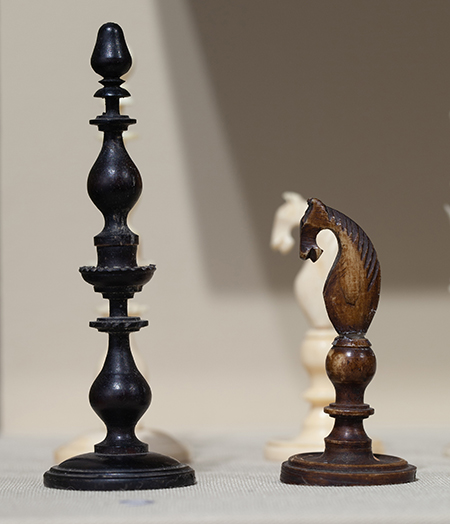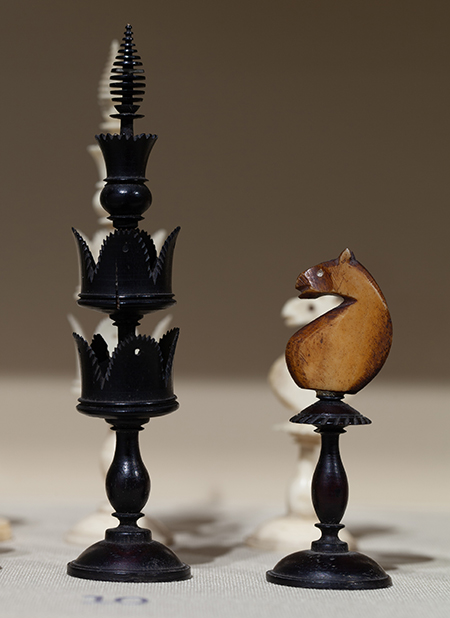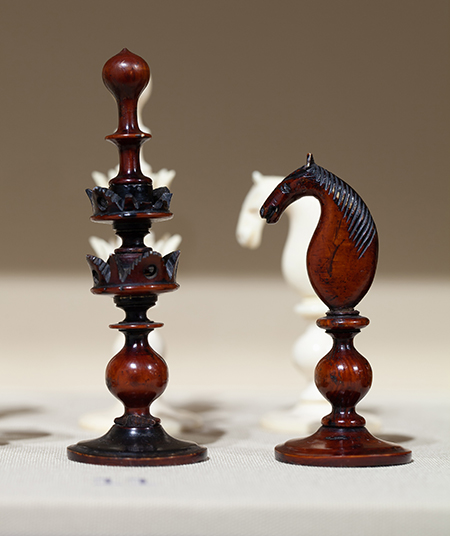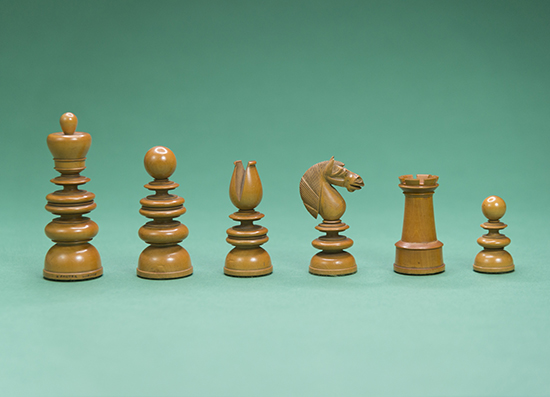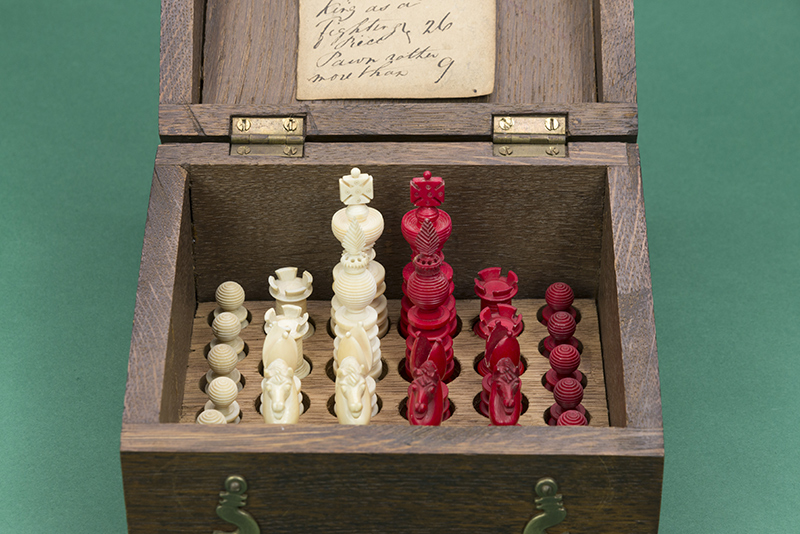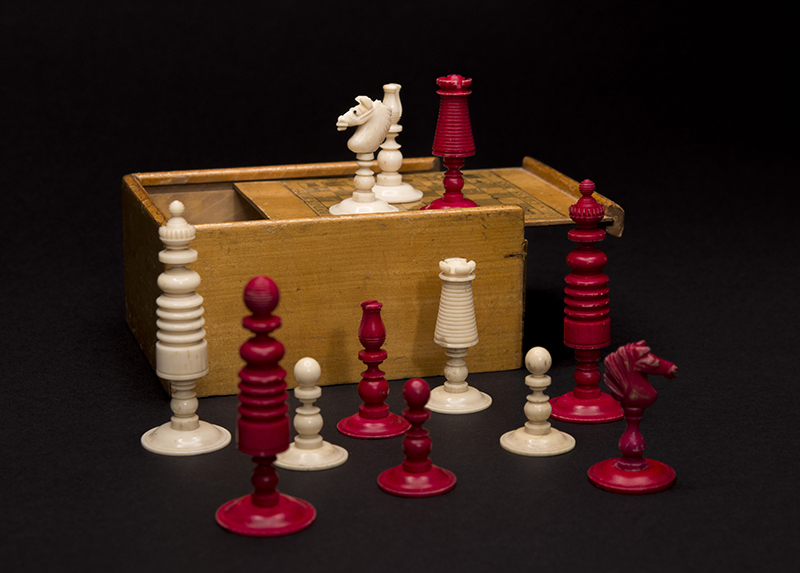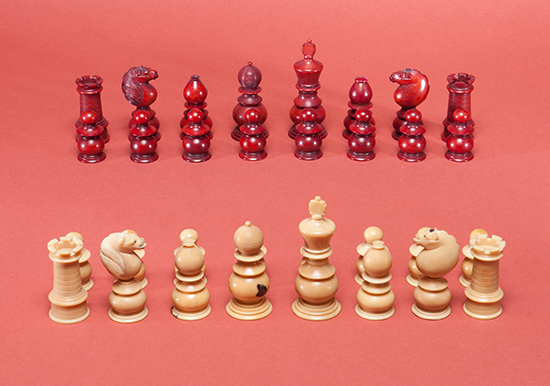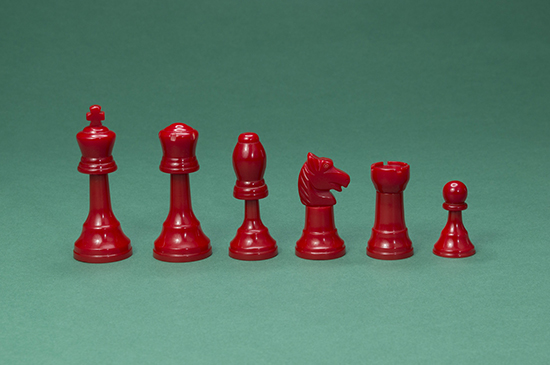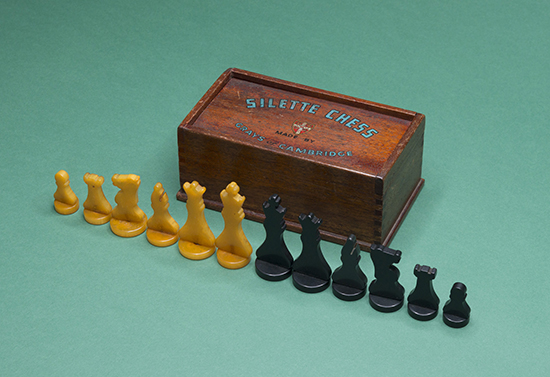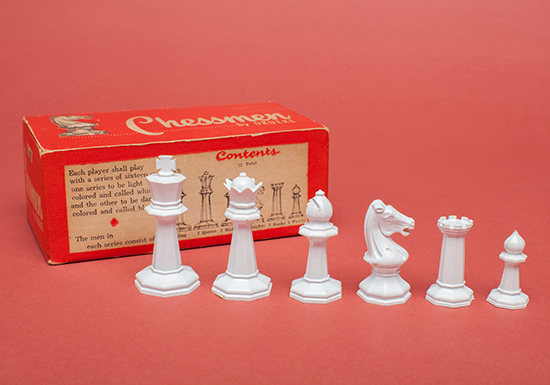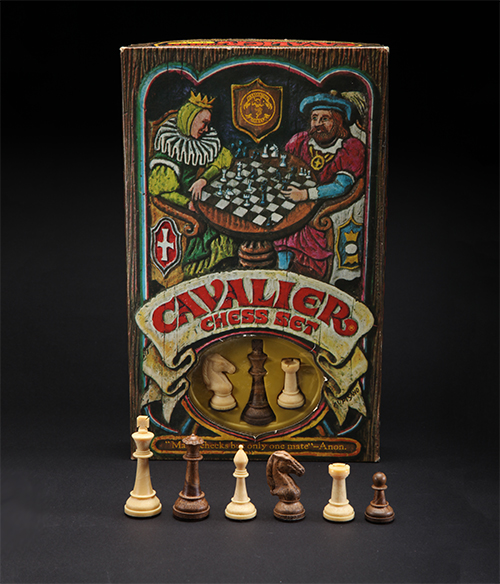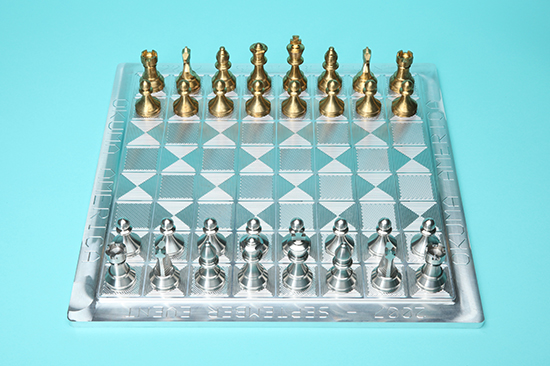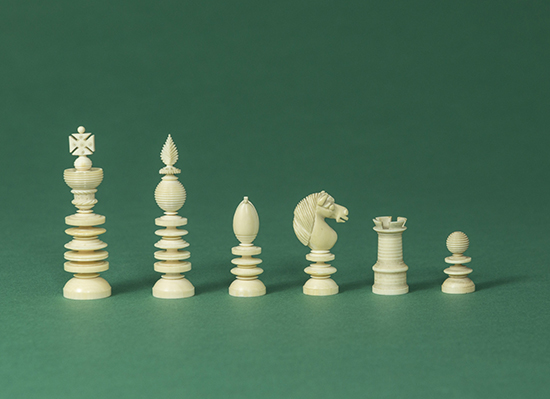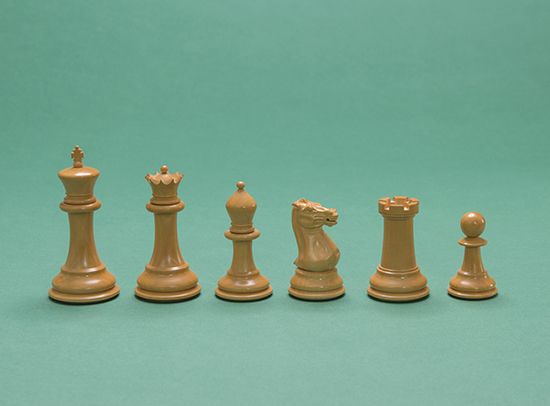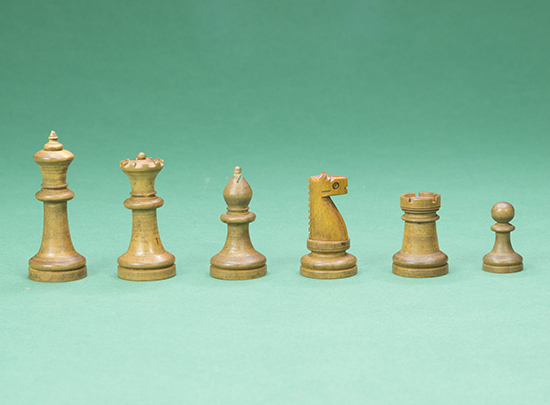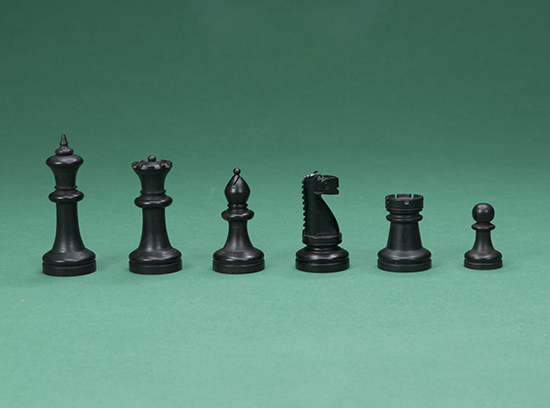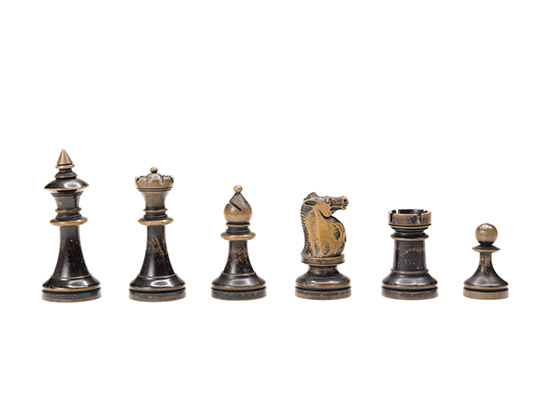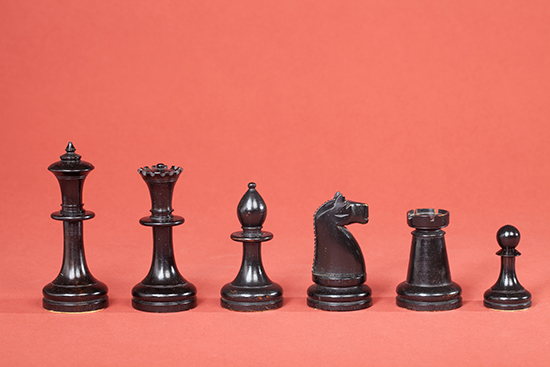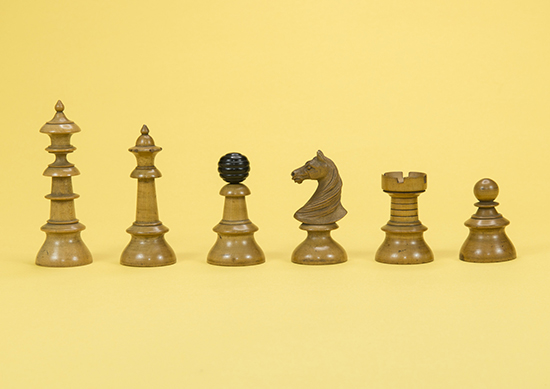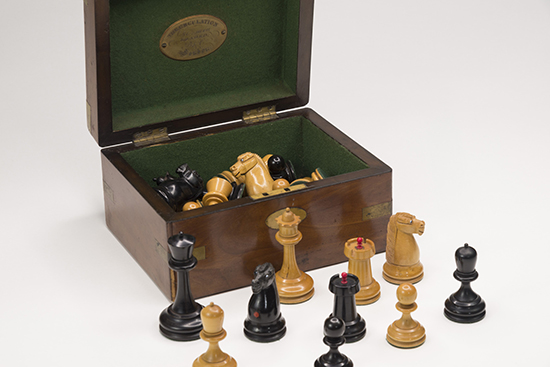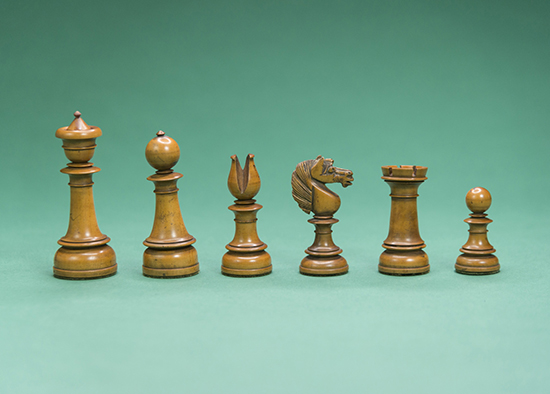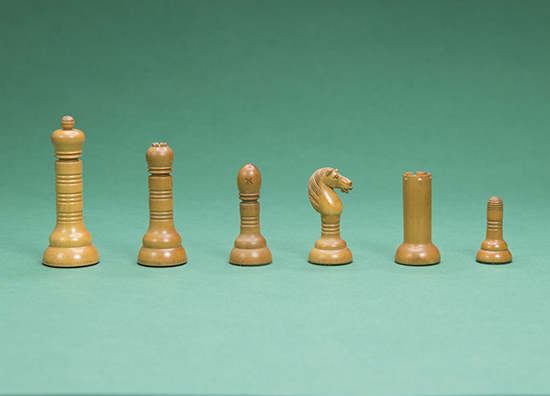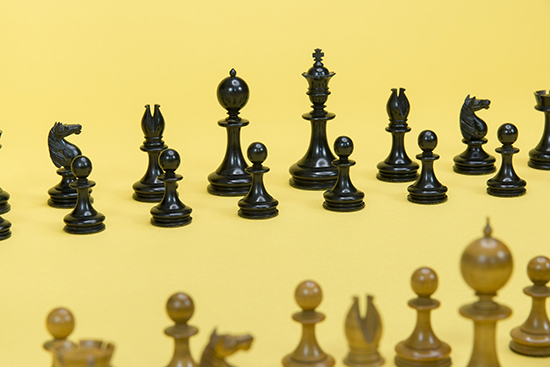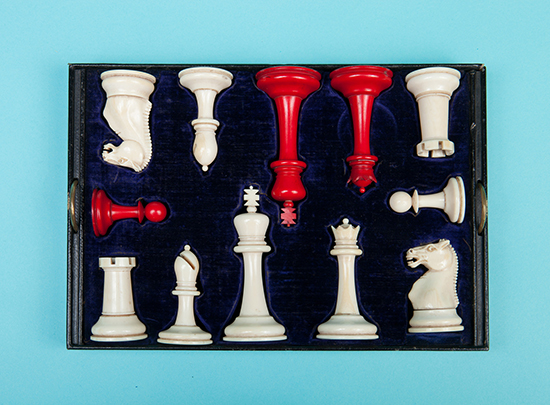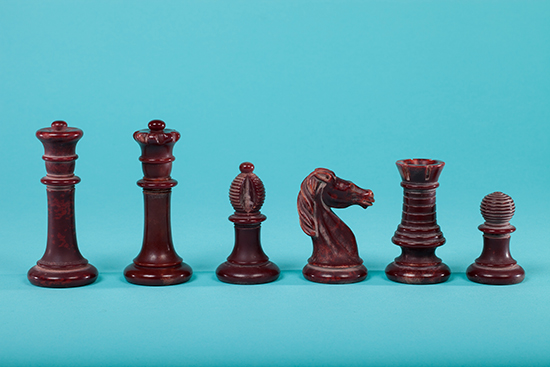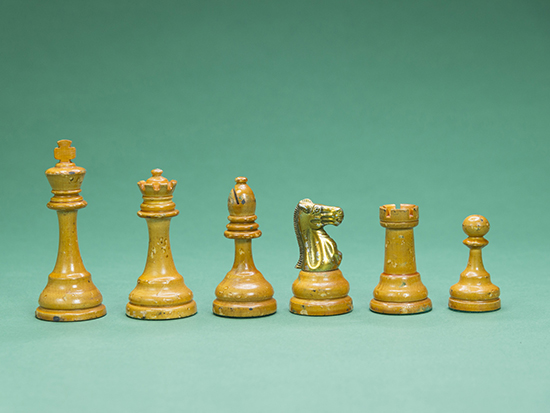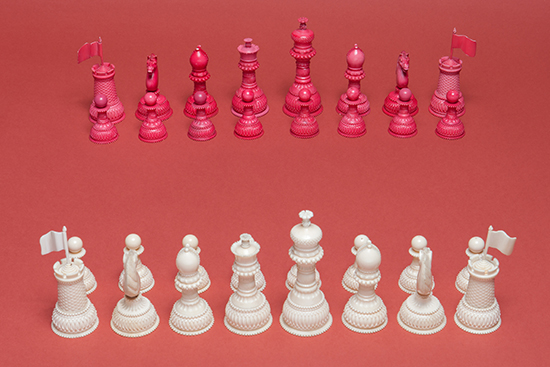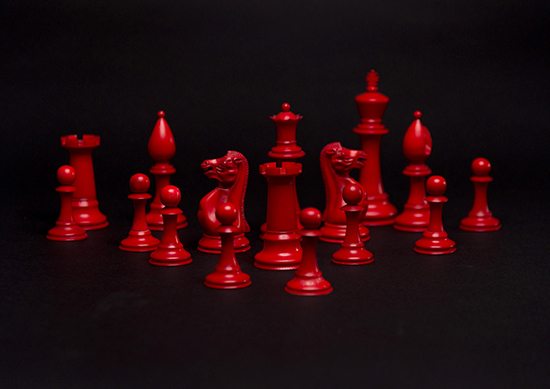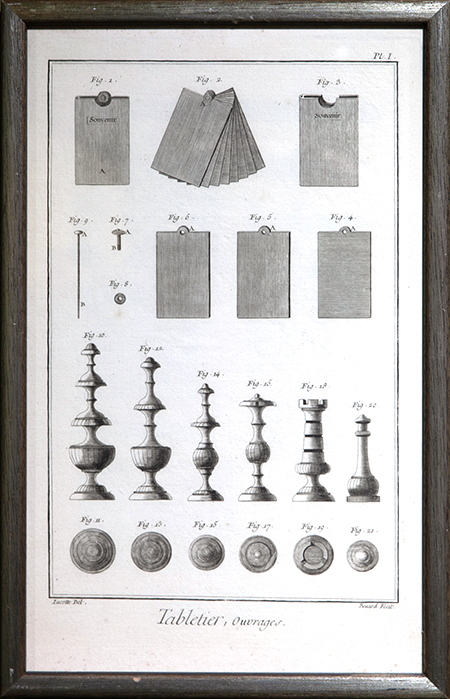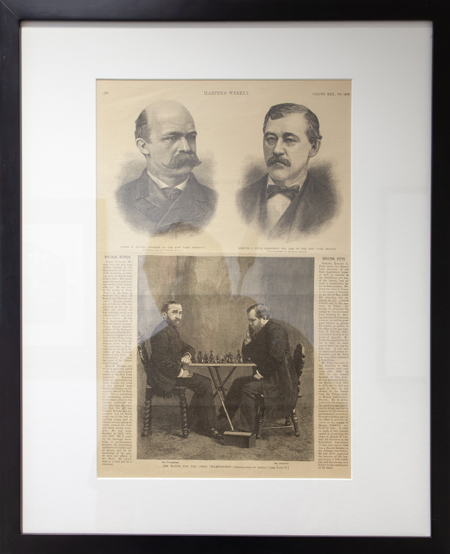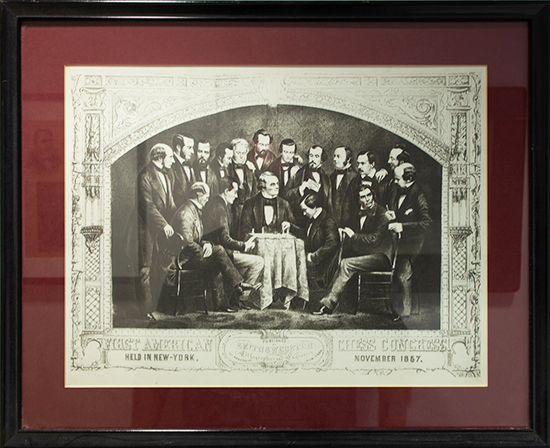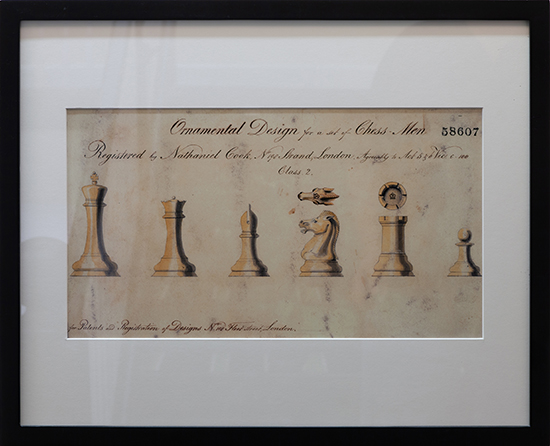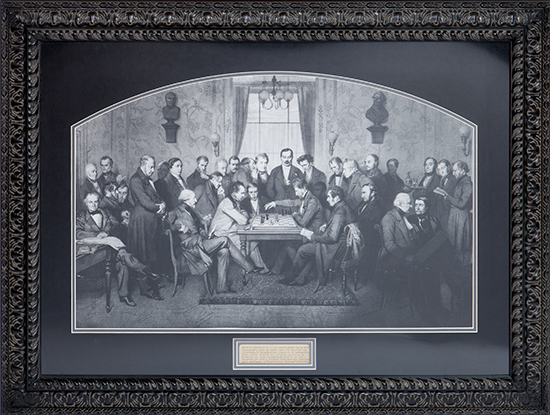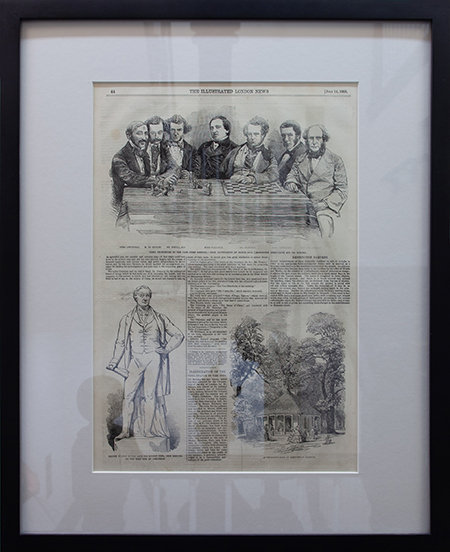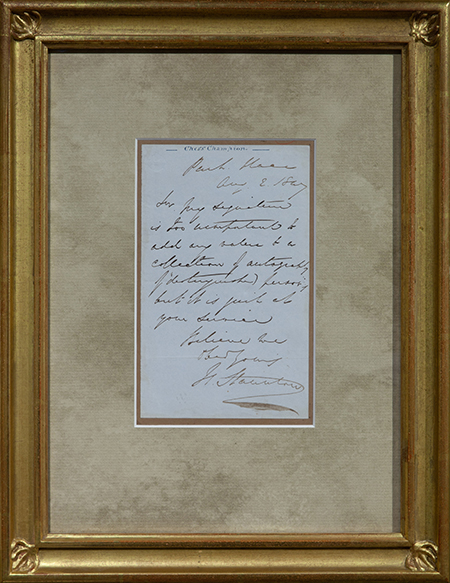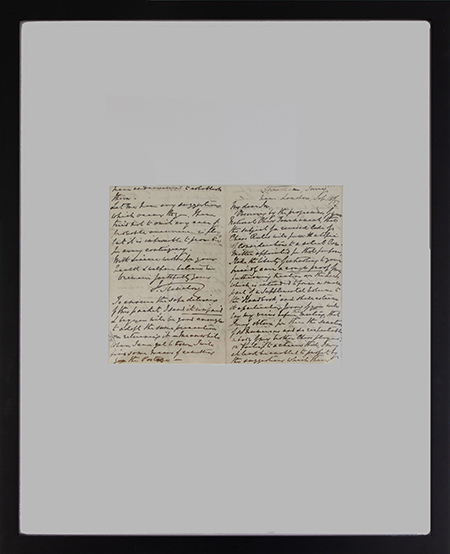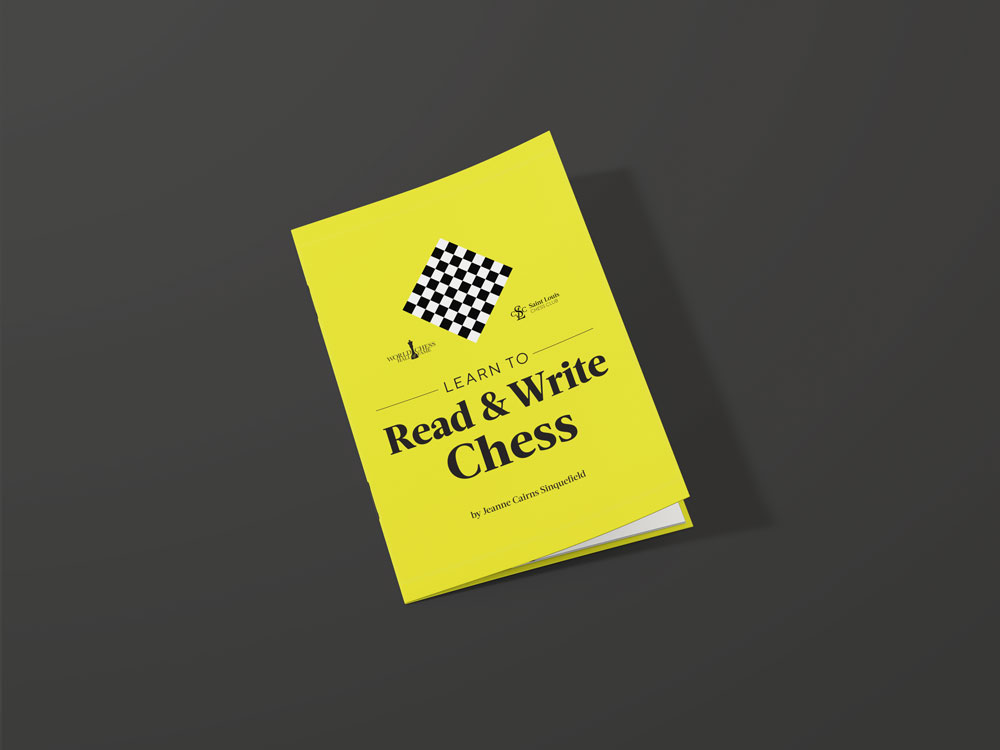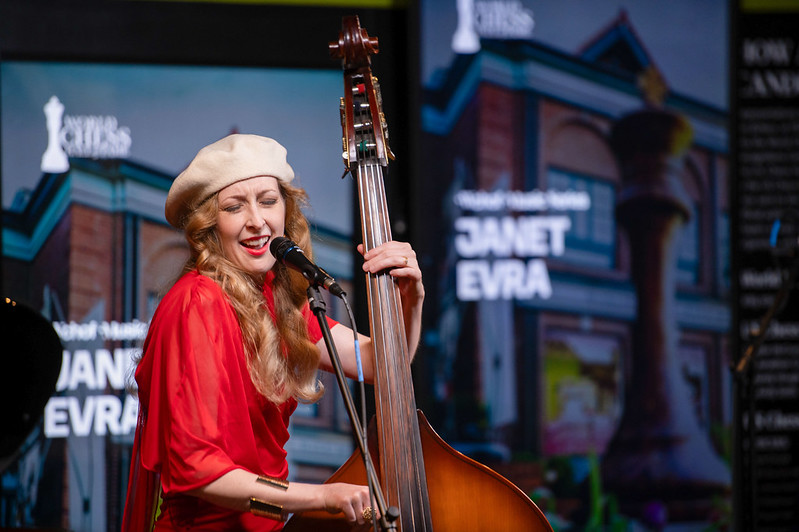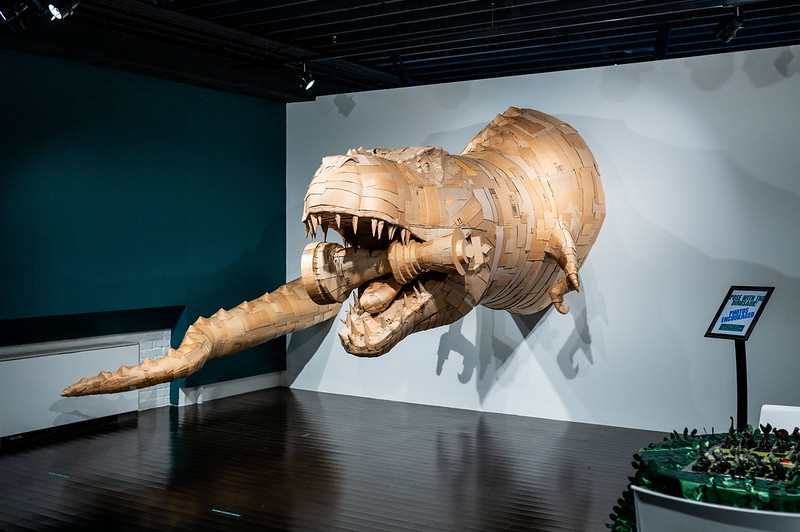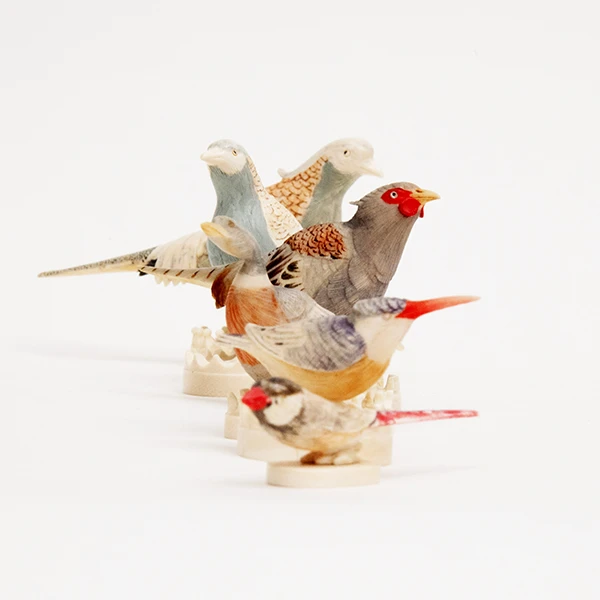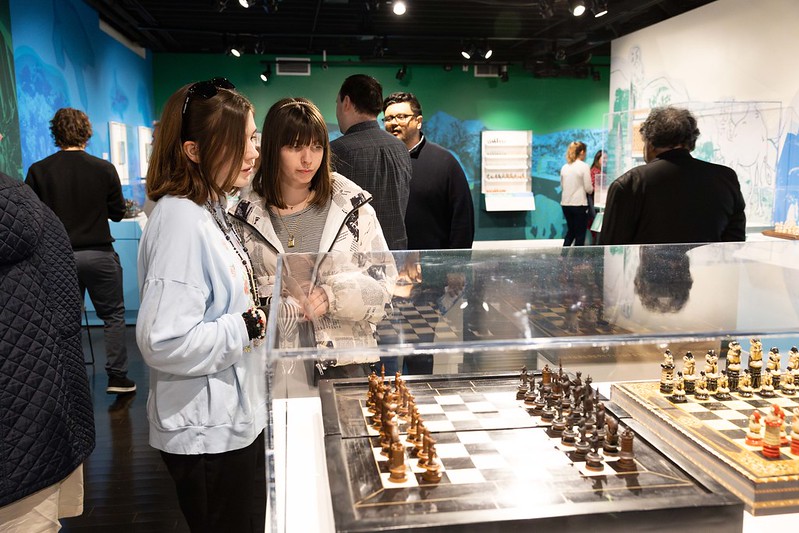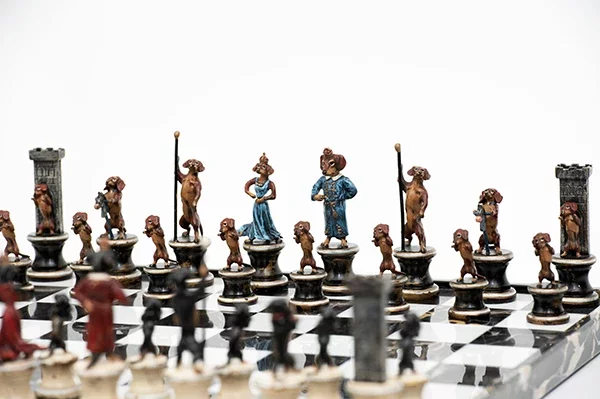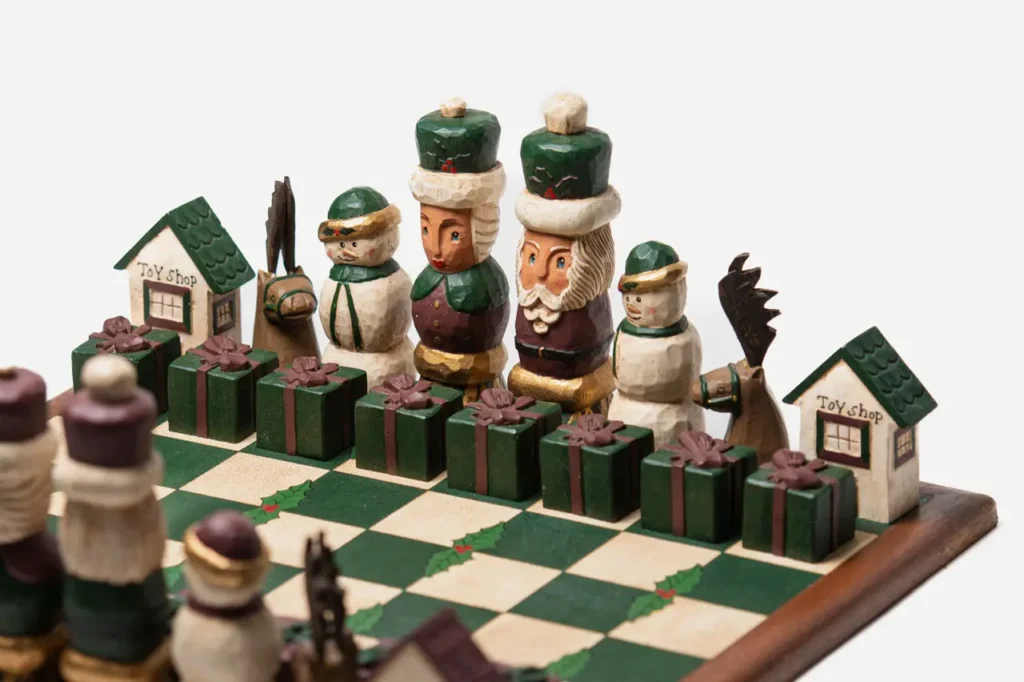Originally, the Staunton chessmen were sold in two sizes: a Standard size (8.9 cm) and a Full Club size (11 cm king) only. This set’s enlarged scale with a 14 cm king may indicate that it was created for an important client. This set is the subject of debate: while some of the world’s top experts in the sets believe it to have been Staunton’s own set, its current owner believes that it could have been made for another individual.
April 12, 2018 - September 16, 2018
The Staunton Standard: Evolution of the Modern Chess Set

Exhibit Overview
Photography by Michael DeFilippo
Artifacts: Collection of the World Chess Hall of Fame, gift of the House of Staunton; Collection of Jon Crumiller; Collection of Dr. Jeanne and Rex Sinquefield; Collection of the World Chess Hall of Fame; Collection of the World Chess Hall of Fame, gift of Hartwig Inc.; Collection of the World Chess Hall of Fame; Collection of Jon Crumiller
The Staunton Standard: Evolution of the Modern Chess Set
2018 marks the tenth anniversary of the Saint Louis Chess Club (STLCC), which now hosts some of the United States’ and the world’s most prestigious chess tournaments, making it the perfect time to examine the history of the Staunton chessmen. Their familiar pieces are used in these competitions as well as elite tournaments around the world. The Staunton chessmen, first introduced to the public in 1849, are now so well-known that their form is taken for granted. However, they only rose to prominence through the efforts of their namesake, 2016 World Chess Hall of Fame inductee Howard Staunton (1810-1874). Staunton, a top player of the 1840s as well as a writer and promoter of chess, was an early proponent of the set during a time when multiple styles of sets proliferated throughout Europe and around the world. Its advantages were clear, as stated by Staunton himself in a June 2, 1850, issue of the Illustrated London News. “In the simplicity and elegance of their form, combining apparent lightness with real solidity, in the nicety of their proportions one with another, so that in the most intricate positions every piece stands out distinctively, neither hidden nor overshadowed by its fellows, the ‘Staunton Chess-men’ are incomparably superior to any others we have ever seen.”
First produced by Jaques of London, competing firms quickly imitated the pattern. Jaques produced ads warning, “Caution—As spurious imitations are sometimes offered, purchasers are requested to observe Mr. Staunton’s signature on the box, without which none are genuine.” By 1863, publications from locations as far-flung as Australia’s Sydney Morning Herald declared a local auction house would be selling “Solid ivory Staunton chessmen, as used in the Paris and London clubs.” The New York Times published an 1853 ad for Bangs, Brother & Co. advertising “Several elegant sets of the STAUNTON CHESSMEN with the Carton Pierre Box,” and in 1873, the Helena Weekly Herald declared that players in Bozeman and Deer Lodge, Montana, would compete in a telegraph match with Staunton chessmen of English manufacture as the prize. Additionally, U.S. and World Chess Hall of Fame inductee Paul Morphy (1837-1884) challenged Staunton to a match in 1858 to be played, “with Staunton chessmen of the usual club-size, and on a board of corresponding dimensions.” During his 1858 visit to Europe, Morphy also challenged “Alter,” a strong well-known amateur player to a match with a set of ivory club-size Staunton chessmen as a prize for the winner of the first five games. Though Jaques warned of imitators, the pattern’s popularity could not be denied, and by the late 19th century, the set was mass-produced by multiple companies.
The 20th century saw a number of innovations for the set, from its aforementioned mass-production in a number of materials from wood to Bakelite, catalin, lead, and plastic, to the 1998 introduction of Digital Game Technology (DGT) boards and pieces. DGT boards, which record the moves of the pieces, allowed chess fans to follow games as they happen rather than waiting until they were published in chess periodicals. The Staunton Standard: Evolution of the Modern Chess Set contains examples of Staunton and Staunton-style chess sets from the 1840s through the present-day, showing how the set has both become a tradition as well as how creators have customized it to make it their own.
The show includes spectacular sets from the collection of Jon Crumiller, who owns some of the earliest Staunton Chessmen created. Crumiller has worked with the World Chess Hall of Fame on two previous exhibitions: Prized and Played: Highlights from the Jon Crumiller Collection (May 3 – September 15, 2013) and Encore! Ivory Chess Treasures from the Jon Crumiller Collection (May 14 – October 18, 2015), lending both sets from his collection and his knowledge of antique sets and their makers. His collection contains over 600 sets from more than 40 countries, with the earliest set dating from the 11th century.
Shannon Bailey, Chief Curator, World Chess Hall of Fame
Emily Allred, Associate Curator, World Chess Hall of Fame
The Staunton Chessmen: Rook of Ages
Chess games are often won by the heroics of a single well-placed piece on the board: proverbially, the right chessman in the right place at the right time. In a larger context, the English chess champion Howard Staunton was precisely the right man to introduce and endorse a new universal design for chess pieces. And in the right place, at the right time: Victorian London was a locus of the world’s chess activity, as chronicled by Staunton in his weekly chess column in the Illustrated London News (ILN).
Howard Staunton never claimed to be the designer/creator of the chess piece pattern that bears his name. The Staunton chess pattern was patented in March 1849 by Nathaniel Cooke (misspelled as “Cook” on the patent document). Cooke was the business partner and brother-in-law of Herbert Ingram, the primary founder of the ILN. Although the Staunton design is officially attributed to Cooke, speculation abounds as to other possible contributors—perhaps John Jaques, the manufacturer of the first Staunton chess sets; or perhaps Staunton himself influenced the design in some way.
Regardless of the set’s actual designer, the direct connection of Staunton’s name with the new design was a savvy and effective marketing tactic. Celebrity branding is common these days—Air Jordan sneakers and the George Foreman grill come to mind—but all of today’s named products share a marketing ancestor: Howard Staunton was one of the earliest celebrities in modern history to lend his name to a product. And Staunton’s name carried considerable weight within the chess audience of his far-reaching weekly ILN column. And indeed, he advertised the Staunton pattern relentlessly in his column. The first mention comes in the September 8, 1849, ILN issue:
“The Staunton Chess-men.” — We have lately been favoured with a sight of the newly-designed Chess-men you speak of, and shall be greatly mistaken if, in a very short time, these beautiful pieces do not entirely supersede the ungainly, inexpressive ones we have been hitherto contented with. In the simplicity and elegance of their form, combining apparent lightness with real solidity, in the nicety of their proportions one with another, so that in the most intricate positions every piece stands out distinctively, neither hidden nor overshadowed by its fellows, the “Staunton Chess-men” are incomparably superior to any others we have ever seen.
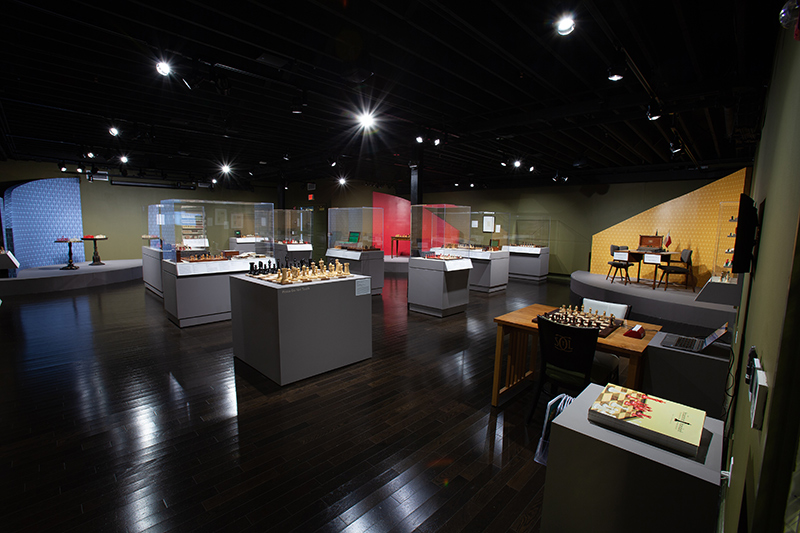
Photo by Michael DeFilippo
Staunton repeated these accolades, and others, in column after column. All 16 subsequent columns in 1849 touted the benefits of the Staunton pattern, as did the vast majority of columns in 1850, and onward, spanning over a 20-year period. And Staunton’s efforts were gradually rewarded, not due solely to his diligence, but also due to one important fact: he was right! For the actual playing of chess games, the Staunton pattern is indeed “superior to any other” with “simplicity and elegance of their form, combining apparent lightness with real solidity.” Especially when compared to the prevalent chess patterns of the era, e.g. the Old English pieces, with short pawns often hidden behind other pieces; or the Barleycorn and Edinburgh patterns, easily tipped over; or the ornamental patterns, fragile and breakable; or, in France, the Directoire and Régence patterns that could be knocked askance with the slightest errant touch.
It took quite a while for the new design to become popular. Initial sales were slow, in spite of Staunton’s frequent assertions to the contrary in his weekly column. A portrait of Howard Staunton posing with other leading chess players in the July 14, 1855, issue of the Illustrated London News includes a Barleycorn set, not a Staunton set, on the table! But slowly, surely, the advantages of the Staunton standard won out over all others, and by the end of the 19th century it had become the prevalent chess set pattern. Other patterns were still marketed in chess manufacturers’ catalogs, even well into the 20th century, but the dominance of Staunton’s standard continued to increase until it became the only chess set design allowed in major chess tournaments, starting in the 1920s.
Howard Staunton’s preeminent place in history would have been assured solely on his exploits as the world’s top player in the 1840s. Or solely on the chess literature he produced: 1,440 weekly ILN chess columns, a dozen chess books, several magazines, and hundreds of articles. Or on his relentless efforts to popularize the game. Or even on his other endeavors, as a Shakespearean scholar (he wrote a 3-volume, 2,400-page book series on Shakespeare’s plays) or as an authority on education (he authored The Great Schools of England, a treatise on educational reform). But first and foremost, Staunton’s legacy is inevitably linked to the chess set pattern, “superior to any other,” that bears his name: the Staunton standard.
—Jon Crumiller
A longtime chess fan and competitor, Jon Crumiller purchased his first antique chess set online in 2002. This acquisition quickly sparked a passion, and Jon’s collection of antique sets now numbers over 600. It includes pieces originating from over 40 countries, dating back to the 11th century (and gaming pieces dating to 3000 BCE), unique sets owned by 18th- and 19th-century royalty, and made from materials such as jade, silver and gold, bone, wood, and precious stones, among others.
The scope of his collecting has also grown to include chess boards, timers, and chess miscellanea, mainly from the 19th and 20th centuries. Now recognized as one of the greatest chess set collections in the world, the artifacts he has gathered serve as a visual history of the diverse ways that cultures across time and around the world have interpreted the game of kings. Portions of Crumiller’s collections have been highlighted in two previous WCHOF exhibitions. Not only interested in acquiring artifacts but also learning about their origins and histories, Jon conducts research on the evolution of chess set styles, usage, and manufacturing. He shares this information with the global community of collectors, including his fellow enthusiasts in Chess Collectors International. Jon provides curious chess devotees from around the world with beautiful photos of his stunning collection as well as some of the fruits of his meticulous research through his website www.chessantique.com.
On Collecting Staunton Chessmen
My chess set collecting obsession had its start a few months after I first learned the moves of the game. That was the summer before my 16th birthday. A few friends in my new neighborhood took the pains to explain the moves to me and I was addicted. All I could do was eat, drink, and sleep chess. I was entering my junior year in high school. I turned 16 in the fall of that year and, for my birthday, my mother gave me a nice set of wooden Staunton chessmen. These were nothing spectacular, just a good, solid, German-made weighted set of lacquered chessmen in a wood slide-top box. The pieces were tournament size, and I made good use of them in the years that followed.
First, having been a serious tournament chess player, my interest was in practical playing sets—the Staunton design in particular. What I had discovered very early in my collecting career was that there was woefully little information on the Staunton chessmen and what did exist was mostly incorrect. So, I decided to pull together as much information on the Staunton pattern as I could.
The Staunton chessmen were designed and first manufactured in the United Kingdom by the firm of John Jaques. I obtained a copy of the design registration for the Staunton chessmen from the patent office in London. The Staunton chessmen design was registered as number 58607 on March 1, 1849. The title of the registration was “Ornamental Design for a set of Chess-Men.” It was registered by Nathaniel Cooke, 198, Strand, London, under the Ornamental Designs Act of 1842. Interestingly, the registration was limited to Class II, articles fabricated mostly from wood.
The Chessmen:
The original Staunton chessmen produced by John Jaques were and still are quite unique in appearance. Although generally described as a radically new design for their time, the form was based on the earlier Edinburgh Upright Chessmen which were designed in the 1840s by Lord John Hay. The Staunton chessmen featured very broad bases, gracefully contoured stems and attractively turned and carved headpieces. From the graceful Formeé cross atop the king to the six-crenelled rook, these chessmen make an impression. The knights, however, are their hallmark. They were derived from the visages which adorn the Elgin Marbles, which form a part of the east Pediment of the Greek Acropolis. The “Marbles” were “expropriated” in 1816 by Sir Thomas Bruce and brought to London. They can be viewed today at The British Museum in London.
The original Staunton Chessmen were available in a Standard size (8.9 cm king) and a Full Club size (11 cm king) only. The original chessmen were available in boxwood and ebony, ivory and Wedgwood Carrara(!). This latter is largely unknown to both the Wedgwood and the chess collector communities. Jaques originated the praxis of weighting their chessmen for enhanced stability. In a true Jaques set, the king’s crosses are removable. Also, the knights are two pieces—the head and the base-which are screwed together. Jaques was the first chess set manufacturer to affix the symbol of a king’s crown to the summits of the kingside rooks and knights. This praxis was largely copied and is not unique to sets produced by Jaques. Every Jaques chess set will have “Jaques London” imprinted on the upper part of the rim of the base of the white king if the set is boxwood and ebony and on the underside of the base of the ivory king. Both kings are so marked for sets produced after around 1890.
Registration Certificates:
Each chessman in a Jaques set, sold during the first three years of production, had a small green paper disk affixed to the underside of their bases. This disk bore a registration mark consisting of a small diamond which identified the day, month and year the design was registered, the class, and a parcel number. This protected the design from piracy during those three years. Although the pamphlet from the patent office in the UK lists one registration disk design for 1849, the year the Staunton chessmen were registered, I have discovered that there were actually three designs printed and distributed. The first two had printing errors and omissions. These were used from 1849 to 1852.
Boxes and Carton-Pierre Caskets:
Perhaps the most intriguing aspects of collecting Jaques Staunton are the richly adorned Gothic style Carton-Pierre caskets in which they were housed. These caskets were designed by Joseph L. Williams. Matching Carton-Pierre treatment adorned leather chess boards were designed and sold by William Leuchars and first offered to the public in December, 1849. Chessmen were initially housed in hinge-top mahogany boxes with a semi-mortise lock and key, Carton-Pierre caskets in three configurations for “unweighted” wooden and ivory chessmen, and the large Spanish mahogany coffer with removable compartmented trays for the club-size ivory chessmen.
The mahogany boxes which housed the earliest boxwood and ebony chessmen were distinctive. They had unique handmade dovetail joints, soft, slightly rounded corners, and they bore their manufacturers label on their undersides. Some of the earliest boxes also bore a small green label on the underside of the lid. Printed on that small label were the words “The Staunton Chessmen Jaques, London.” This label is quite rare and a good indication that the box is one of the earliest made to house the Staunton chessmen. Later mahogany boxes would carry their labels on the underside of the lid. This did help preserve the labels since they were not placed directly on a wear surface.
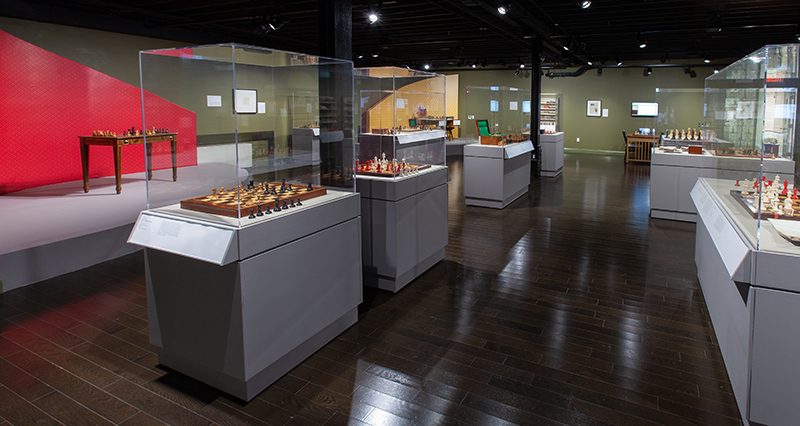
Photo by Michael DeFilippo
Early Labels (1849-1851):
Each box bore a manufacturer’s label affixed to the underside of the box or on the bottom inside of the large Spanish mahogany caskets. This praxis was later changed to affix the label to the underside of the lid of the mahogany boxes. The earliest labels were white with a decorative black fleur-de-lis. A slightly different label was designed for sets numbered 600 or so to 999.
Along with the box contents and registration number (58,607 5&6 Vict. Cap. 100.), each label bore an original (not a facsimile) signature of Howard Staunton and the production number of the set, also in Staunton’s hand. Based on certain observations, I believe Staunton hand-signed and numbered 999 labels (or signed as many as he could until hampered by writer’s cramp).
These early labels were numbered sequentially, so set #120 could be an 8.9 cm wooden set in a small mahogany box, while set #121 might be a large ivory set in a large Carton Pierre casket. Little known is the fact that the earliest labels also have the Jaques London imprint invisibly embossed into the label. The same tool used to mark the bases of their kings was used to make this imprint. This little-known fact alone should be worth the time you have taken to read this article. These labels were used for sets sold during the first two years of production.
Numbered Labels (1852-1856):
After three years, the design registration expired and was not renewable. On August 11, 1852, Nathaniel Cooke entered into an arrangement with Howard Staunton for the exclusive use of his name and facsimile signature on the labels. This next group of labels was produced under this new arrangement. Labels within each of the three color groups were numbered sequentially without regard for the size of the chessmen.
The Leuchars Factor:
The earliest advertisements for the new Staunton chessmen have the following statement: “The Nobility and Gentry are respectfully informed that these new and elegant CHESS-MEN are now obtainable of W. Leuchars, 28. PICADILLY …” The earliest Jaques chessmen were sold through Leuchars and are quite valuable and have unique features. The Jaques London mark on the bases of both the wooden and the Ivory sets were over-stamped “Leuchars.” In the case of the ivory sets, the Jaques London mark is actually scratched out and over stamped. In addition, a Leuchars green sticker was affixed to the underside of the white king’s base. Leuchars ivory sets were sold only in Carton-Pierre caskets and only in the 8.9 cm king. The label on the bottom of the casket originally bore a green Leuchars sticker. Leuchars ivory sets also featured a very unique knight design which was clearly distinguishable from the more normal Jaques knight. Leuchars only offered boxwood and ebony sets in the 8.9” king. Unlike Jaques, Leuchars also offered lead-weighting in the smaller boxwood and ebony sets sold between 1849 and 1852. Although somewhat difficult to see, the Jaques London mark on the upper bevel of the king’s base is over-stamped Leuchars.
The Design Evolves:
The Jaques Staunton chessmen have evolved over the 150 or so years since their introduction. Many of the changes were made to improve the robustness of the chessmen. Among the other changes made were the relative proportions of the chessmen. Queens and pawns were made taller. The weight of the chessmen was increased. Boxes and labels also underwent significant changes. Boxes housing sets produced after 1895 or so were fitted with a partition which separated the white pieces from the black. Labels changed every five years or so.
—Frank Camaratta
The full version of this article first appeared in the November 2008 issue of Chess Life.
Frank Camaratta is the internationally-recognized expert in antique Staunton and other playing sets. Between 1986 and 2010, he owned one of the world’s largest collections of Jaques and Staunton-style sets, which numbered well over 1,000 sets. He has been a serious collector and researcher into antique playing chess sets, their design and history since 1986. His serious research, which started in 1989, was centered on Jaques and other Staunton chessmen and quickly expanded into Pre-Staunton playing sets. Camaratta is a serious chess tournament player, national title holder, International Correspondence Chess Master, collector, and historian with a broad educational and professional background. He purchases and sells chess collections, large and small, and has provided numerous appraisal and research services. In addition, Camaratta has brokered the sale of several large collections in the States and overseas. In 1990, Camaratta founded The House of Staunton, Inc. and later, The House of Staunton Antiques, LLC. His website is chessantiques.com.
This exquisite set is a supersized version of the set that Frank Camaratta created for the 2013 Sinquefield Cup, a tournament held annually at the Saint Louis Chess Club that includes the greatest players in the United States and the world. The king in this set is over double the height of the one in the Sinquefield Cup set, which is also on view in this gallery. The Sinquefield Cup set itself is a smaller version of the Imperial Collector set. This oversized set is one of only two that exist—the other is a gift from Camaratta to Rex Sinquefield, the founder of the Saint Louis Chess Club and the World Chess Hall of Fame.
Two of the popular styles of English playing sets that were displaced by the Staunton style are displayed here on a pair of beautiful Victorian chess tables. John Calvert created the Calvert Stamped set. After his 1822 death, his wife Dorothy Calvert then took over and kept his company running. She then sold the stock in 1835 and later died in 1840. The set is displayed on a table with elaborate penwork imitating the appearance of a “specimen table” or a tabletop inset with different varieties of marble.
An elegant English ivory chess set is paired with the tilt-top table. The set includes elements both typical of pre-Staunton playing sets, such as stacked “collar” decorations on the pieces, as well as ornamental elements like the waving rook flags.
Advertisements indicated that early Staunton chessmen, like the ones on view here, were available in boxwood and ebony, ivory, and Wedgwood Carrara. Though made from wood and ivory, which were conventional materials for playing sets during that era, Staunton chessmen included a number of innovations, even aside from their forms. Jaques originated the praxis of weighting their chessmen for enhanced stability. Additionally, Jaques was the first chess set manufacturer to affix the symbol of a king’s crown to the summits of the kingside rooks and knights. Howard Staunton himself indicated that this would aid players in their study and analysis of games.
This mid-century modern set of table and chairs as well as the chess set displayed on it were created for the 1966 Havana, Cuba, Chess Olympiad. Chess Olympiads are biannual chess competitions featuring teams of players representing countries around the world. The Havana organizers made special efforts to make it one of the best Olympiads in history. In a December 1966 article in Chess Life, U.S. team member Larry Evans noted that it was the “biggest, best organized, and best run to date” and that organizers reportedly spent 1.3 million pesos on the event. After the event was over, the organizers sent tables and chess sets to Board One players and important FIDE (Fédération Internationale des Échecs or World Chess Federation) officials around the world. Fred Cramer, then Zonal President for the United States, received the table on display, while International Master Nevzat Süer, who played Board One for Turkey, received the set. The table has replica flags and name placards. Since the tables were used continuously throughout the tournament, it is impossible to tell which players competed at specific tables; however, no matter who played on this table, it is an important part of chess history.
In addition to being one of the greatest players of his era, Howard Staunton was also an author of chess literature and a Shakespearean scholar. On view in this exhibition are two copies of his 1849 book Chess Praxis, which were once owned by two of the United States—and world’s—best players, Paul Morphy and Bobby Fischer. Alongside them is a copy of The Chess Player’s Handbook, which Staunton noted would be included with the Staunton chessmen along with the carton-pierre casket in his Illustrated London News column.
In 1883 the Tees Side Chess Association was formed to connect the smaller chess clubs that covered Cleveland County in northeast England. As can be seen by the multitude of plaques on the box, this set served as the trophy for the association’s annual chess tournament between 1886 and 2003. The board has peg-holes on the side where pegs could be placed to keep track of wins and losses. The set was made by Jaques of London, the original manufacturer of the Staunton style, and its use as an award demonstrates how the Staunton chessmen had not only become the standard among serious chess players, but were venerated enough to be used as a trophy.
From late 19th century to early 20th century, Richard Whitty manufactured Staunton-pattern chessmen from his workshop in Liverpool at 14 Tithebarn Street. His local claim-to-fame was as a manufacturer of fancy fishing tackle, which was probably sold in his brother’s store, along with chess sets, cribbage boards, and other items. His Staunton sets are known for their large aggressive knights, as well as other characteristic features such as domed queens and red felt on the bottoms of the pieces.
Established in 1890, the British Chess Company (BCC) only operated for about fifteen years, but in that time had a lasting impact. The company was not only a leading producer of chess equipment, but also was part of the first major attempt to standardize the rules of chess for a broad audience. These rules were first adopted by the British as the British Chess Code and later by Americans, as the American Chess Code.
With pegged pieces and accompanying holes in each of the squares to prevent the pieces from shifting, this set is ideal for travel. Jaques produced many travel sets, including one called the “In Statu Quo” that featured a unique locking mechanism that kept the pieces in place in a position during bumpy travels.
This early set of Jaques Staunton chessmen is paired with a beautiful Leuchars board, which has decorative elements that refer to chess pieces on its corners. The back of the board has paper maché decorations that complement those on the casket, or box, containing the chess pieces. Leuchars was the first retailer of Staunton chessmen, which it began selling in September 1849. It began to sell boards like this one in December 1849.
A month before the boards went on sale, an article in The Morning Herald praised the set and outlined the creators’ ambitions to promote it on both its practical and artistic merits. The article stated, “The ‘Staunton,’ so far as we can judge, seems to combine all the advantages that a chess player craves…the greatest and most significant improvement is observable in the knight…The snorting nostrils, and the curved, narrow crest, are indicated with great skill; and a more delicate and effective piece of carving could not, we apprehend, be produced. It is this piece that gives the Staunton pattern its chief distinction, and separates it from all others; and its graceful and artistical superiority is apparent at a glance.”
This selection of Staunton Chessmen and Staunton pattern sets relate to some of the most important tournaments and matches in American—and world—chess history. Though the Staunton pattern had risen dramatically in popularity during the 19th century, it was not until the 1920s that it became the standard for tournament play.
In 2013, the Saint Louis Chess Club (STLCC) commissioned Frank Camaratta from The House of Staunton to create a unique chess set for the STLCC flagship event, The Sinquefield Cup (September 9-15, 2013). Camaratta made a total of 10 sets, and they are now in the collections of Dr. Jeanne and Rex Sinquefield, Randy Sinquefield, Katie Sinquefield, Luke Sinquefield, World Chess Champion and 2013 Sinquefield Cup winner Magnus Carlsen, GM Hikaru Nakamura, GM Levon Aronian, GM Gata Kamsky, the Saint Louis Chess Club, and the World Chess Hall of Fame. Camaratta created the first-ever weighted DGT chess pieces for the STLCC. An imperial version of this set is also on view in this gallery.
John “Jack” Collins served as mentor to a number of important American chess players, including Donald and Robert Byrne; William Lombardy; and most famously, Bobby Fischer. Before his success and fame in chess, Collins learned the game as a child from his family landlord Fredrick Huhn. After learning the basics, and no doubt acquiring this set, Collins, in turn, taught five other boys. Together the small band started the Hawthorne Chess Club, named after the street where Collins grew up. The club grew quickly and soon started to compete with other clubs from the area, starting the Brooklyn chess league. The culmination of these events marked the beginning of both Collins’ career as a chess player and teacher. These well-worn Staunton pieces testify to his lifelong love of the game.
Like the Silette Catalin Staunton Variant set on view in this case, the Rose Chess Staunton Variant interprets the Staunton set in silhouette form. The set is named for Mildred Rose, the owner of The Rose Chess Company. This set is especially unique because it was never removed from its case, which even contains the original tissue paper around the pieces.
Founded by William Moffatt and William Hughes, the British Chess Company (BCC) aspired to compete against Jaques of London in producing high-end chess sets. The company began manufacturing sets in 1891. This design contains one of BCC’s major design innovations: the use of xylonite, an early plastic, to create the heads of the knights. Unlike other pieces in a high-end chess set, knights are carved rather than turned on a lathe; using xylonite allowed BCC to mold rather than carve the knights, decreasing the cost and time of creating them.
In this letter, Howard Staunton writes to an organizer of the 1857 American Chess Congress. He speaks of his hopes for the event to further promote interest in the game in the United States. Staunton also included a rough proof of his forthcoming additions to The Chess-Player’s Handbook in order to receive feedback from the players in the tournament. The event included a number of prominent chess players and was won by Paul Morphy.
PRESS
7/25/2018: Business Journal — Photos: See 3 New Exhibits at World Chess Hall of Fame
5/13/18: The Herald Dispatch — Jean McClelland: Knowing where a chess set is from can help determine its current value
4/24/2018: Art Daily — Three groundbreaking chess exhibitions open at the World Chess Hall of Fame
4/5/2018: St. Louis Public Radio — On Chess: The 169-year-old modern chess set
3/22/2018: Press Release — New Exhibition at The World Chess Hall of Fame Explores the History of Staunton: The Game’s Most Iconic Set

